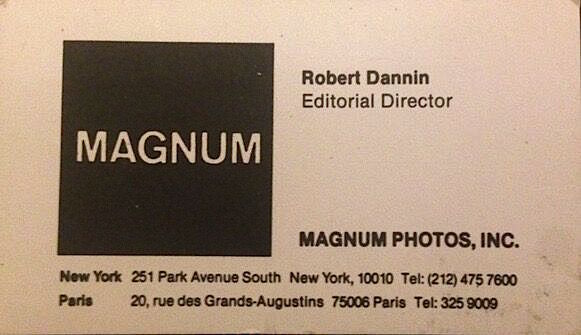 [Editor’s Note: Here we continue “The Dannin Papers,” a series of Guest Posts by Robert Dannin, who served as Editorial Director of Magnum Photos from 1985-90.
[Editor’s Note: Here we continue “The Dannin Papers,” a series of Guest Posts by Robert Dannin, who served as Editorial Director of Magnum Photos from 1985-90.
In this new installment Dannin considers the latest book by renowned photojournalist Eugene Richards, the day I was born, in which, almost 50 years later, Richards revisits the Arkansas Delta region that served as the subject of his first monograph, Few Comforts or Surprises (1973). Part 2 appears below; click here for Part 1. — A. D. C.]
•
The Many Voices of the Arkansas Delta:
Eugene Richards’s the day I was born (b)
by Robert Dannin
•
Defending the FSA Legacy
… The fiery narratives in the day I was born recall previous historical works such as God Struck Me Dead, the post-slavery autobiographies compiled by the WPA Federal Writers Project, or Ted Rosengarten’s biography of Nate Shaw.[1] However, Richards’s visual experiment goes slightly awry due to problems of format and layout. Whereas the book’s contents invite a single reading, the task is burdensome due to its physical format as an unwieldy hardcover (12″ x 9″) coffee-table book weighing more than 3 lbs., difficult to hold at a single sitting, and restrictive as a vehicle for memorializing a history whose actors probably cannot afford to buy it.
A related problem is the layout, wherein the image sequencing interferes with the flow of text by forcing the reader to continually search backwards or forwards to locate the pictures corresponding to the individual narratives. It is a structural defect resulting from the text edit that mixes biographical threads, a proven technique in documentary film interviews yet inapplicable book-wise without shrinking the format and adding more pictures.
Possibly Richards was thinking more like a filmmaker after his 2018 success with Thy Kingdom Come, a documentary about the lives of people in a “big flat” Oklahoma oil town. This too was an experiment, undertaken as a documentary that shadowed director Terrence Malick’s 2012 theatrical production in the same place (To the Wonder) by enlisting one of the actors, Javier Bardem, to conduct interviews with a cross-section of alienated townsfolk — a cancer patient, a Klansman, an elderly woman, a prison inmate, and a mother blamed for her baby’s death. The twist is that Richards films Bardem in the garb of a parish priest, the role he is portraying in Malick’s fictional movie.
Although aware of this ruse, the subjects eagerly seize the occasion to relate their stories to the camera. This complicity is doubled for the audience who must gauge the interaction between the “priest” and his communicants. Are we viewing true confessions? Is the “priest” playing a journalist, or slyly cooperating with Richards’s project? Do the communicants offer their responses to a faux clergyman, a film director, or merely the camera? The effect is unnerving and, as in the day I was born, Richards foreshortens the distance between the viewer and the viewed. With this baroque technique he paints a stark portrait of life in flyover country. The question remains as to whether the method can be transposed into a book.
Richards has a long, illustrious record in gritty documentary photography. His style is unrelentingly critical in its refusal to concede neutral space between the viewer and his subjects. The unmistakable tradecraft of Magnum, his erstwhile agency, is evident in his landscapes without establishing shots, faces not portraits, misery and anguish personified yet never apparently redeemed. Below the Line: Living Poor in America (Consumer Reports Books, 1987) and Cocaine Blue, Cocaine True (Aperture, 1994), his sustained depictions of poverty and addiction respectively, mark a detour from Robert Frank’s dyspeptic gaze back to Jacob Riis’s muckraking agit-prop.
A discerning tourist can expose patterns and register his opinions, whereas the skilled observer with skin in the game has no choice but to reveal where he stands in relation to his subjects. Richards’s photography is a matter of propinquity, aptly summarized in an expression often attributed to the 20th-century American socialist and perennial presidential candidate Norman Thomas: the liberal thinks other people have problems, but the radical knows he’s in a heap of trouble himself. He pulls the reader into his scenes without pointing toward the exit.
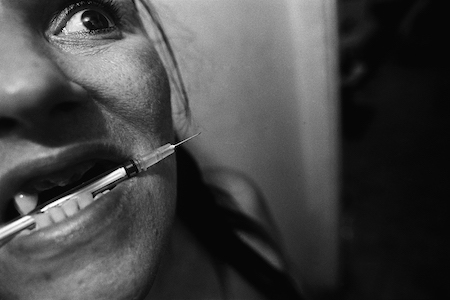
Eugene Richards, from Cocaine True, Cocaine Blue. “BROOKLYN, NEW YORK – SEPTEMBER 1992. ‘Mariella’ ties her arm before shooting up cocaine in September 1992 in the East New York section of Brooklyn, New York. The crack epidemic refers to the period of time between 1985 and 1990 in which there was a huge surge in the use of crack cocaine. Corresponding surges in crime and murder rates in American cities during those years have been attributed to crack dealing and usage.”
I am forever haunted by a picture from The Knife and Gun Club (Atlantic Monthly Press, 1989) his chronicle of the ER at Denver General Hospital recorded at the height of the epidemic of crack-related gang violence. The photograph is framed by hospital linens, a jumble of used surgical instruments, life support machines, wires, and tubes. A solitary corpse lies splayed on the operating table, abandoned by the surgeons and nurses whose frantic efforts have obviously failed. The face of a woman fatally shot in a barroom incident motions upward, perhaps a gesture of disgust over a pointless life. Richards captured this final heave of resentment, the moment of her transition from tortured soul to a piece of dead meat.
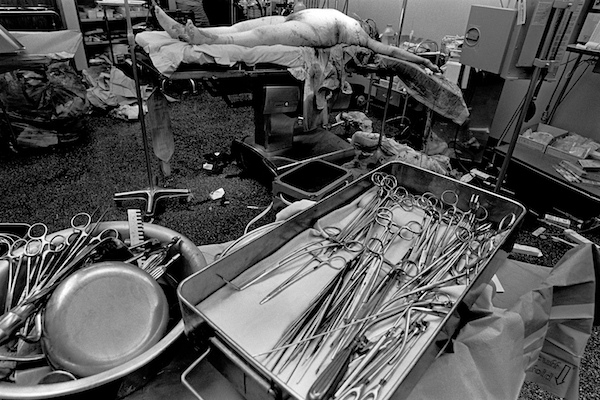
Eugene Richards, from The Knife & Gun Club (1989). “DENVER, COLORADO – 1982: This female patient died of gunshot wounds, despite long hours in surgery performed by emergency room staff at Denver General Hospital in 1982 in Denver, Colorado. She was a bartender who refused to serve a drunk patron one more drink.”
Throughout the same book his images of burned-out, critical-care nurses and physicians demolish the Time-Life myth of W. Eugene Smith’s idyllic “country doctor.” Like the beleaguered doctors fighting COVID-19 today, theirs is the job of Phlegyas, the ferryman who transports the condemned across the River Styx into Dante’s fifth circle of hell.
the day I was born is another reminder of Eugene Richards’ status in the FSA’s legacy of photojournalism. The book’s design and production issues are insignificant relative to the content, because it reaffirms the fundamental principle of the hybrid art form called photo-reportage. Documenting the dispossessed has never been a matter of images versus words, style against substance, or presentation over the urgency to convey reality to an audience too easily distracted by the capitalist hyena press. Access has always been the prime directive in this line of work.
But the main obstacle is the stonewalling by gatekeepers who thwart the public interest. Publishers are always quick to lip-service journalistic principles, yet seldom prepared to invest in making such books accessible to readers and students. In addition to the specious laws of marketing have been added lately a new set of criteria concerning the reporter’s identity — his, her, or their personal authority to represent a given subject.
It would be an unfruitful exercise to cite the countless examples of this kind of censorship, except to conclude that, faced with concern about political correctness, a journalist like Richards needs to choose whether to retreat or push ahead according to his determination and the resources at hand. This consideration includes accountability to one’s subjects, who expect their voices to be heard.
•
Was this the case with the day I was born?
 The story was originally commissioned by the New York Times when a change of venue for an unrelated assignment put Richards in the familiar territory of the Arkansas Delta and its people. There he spotted Timothy Way’s murals on the exterior walls of a store and walked inside to meet the owner, Stacy Abram. The theme of revisiting the violent suppression of the town’s 1970 Civil Rights march emerged from their reminiscences about that event. In the spirit of mutual trust more introductions followed and led Richards to propose a classic restudy, or a people’s history of what happened in Earle fifty years ago.
The story was originally commissioned by the New York Times when a change of venue for an unrelated assignment put Richards in the familiar territory of the Arkansas Delta and its people. There he spotted Timothy Way’s murals on the exterior walls of a store and walked inside to meet the owner, Stacy Abram. The theme of revisiting the violent suppression of the town’s 1970 Civil Rights march emerged from their reminiscences about that event. In the spirit of mutual trust more introductions followed and led Richards to propose a classic restudy, or a people’s history of what happened in Earle fifty years ago.
The Times agreed and furnished “generous support” for this extended assignment, yet inexplicably “went silent” after Richards submitted the finished work. A negative review somewhere in the paper’s editorial hierarchy had apparently killed its publication, yet without offering the courtesy of comment. Arguing that the story he found in Earle was a highly relevant “echo of contemporary race relations,” Richards’s attempts to get an explanation met with further silence. The only postscript came from an insider who opined that the paper was fully engaged in matters of civil rights and race, a reference to the now famously controversial “1619 Project” begun in August 2019 on the 400th anniversary of the beginning of American slavery. As far as the New York Times was concerned the “voices of Earle” were apparently superfluous in light of its reawakened commitment to race matters.
Annoyed by this silence, Richards redoubled his efforts to get the story out. A query to Aperture proved unsuccessful. This nonprofit publisher of two of his critically acclaimed titles, Exploding into Life (1986) and Cocaine Blue, Cocaine True (1994), has lost its mojo since the demise of its director Michael Hoffman in 2001. Under the stewardship of Chris Boot, ever anxious to please the foundation’s wealthy patrons, Aperture promotes retail art photography of the varying, indecipherable genres displayed in Chelsea galleries and Venice Beach kiosks. Pictures and testimonies of the beaten citizens of troubled Earle, Arkansas have no purchase there and would likely provoke the wrong kind of scandal if they had.
Several futile inquiries later, Richards finally opted for his default position to publish the book at Many Voices Inc., a small nonprofit that he and his wife, the writer Janine Altongy, operate to produce their documentary projects and books. Publishing a photography book through a nonprofit with their very modest budget entails constraints on design and marketing. Rather than experimenting with proprietary software or hiring a professional designer, the most efficient method is to use templates that worked well previously.
Printing, expensive even in normal times, proved another problem, because the pandemic necessitated an American printer to obtain the high-quality reproduction generally available abroad at lower prices. With supply chains and international travel at a standstill, not much could be done to mitigate this cost. An even more critical issue involved sales. Absent an advertising and distribution campaign, the book’s small print run had to appeal to a handful of specialty dealers, museum shops, and individual collectors who comprise today’s primary and secondary markets for photography books.
These factors constituted a negative feedback loop to thwart Richards’s initial desire to make the book readily accessible to a mass audience. The e-book alternative might be adequate for use in a high-school history class, but there are few substitutes for the haptic experience of physically holding a photograph (or an excellent ink reproduction thereof) and its accompanying printed personal testimony. One can only hope that the book will be reissued eventually in a more accessible format.
People’s History versus the Grand Narrative
The unresolved question of whether “1619” was a license for the New York Times to ignore the day I was born does not prevent us from considering differences between metanarratives and people’s histories, or the concomitant impact of Richards’s work as an instantiation of the latter in the continuing debate over the relevance of contemporary photojournalism.
That the Times would bypass the history of the survivors of a brutally suppressed protest reveals much about the current state of “woke” journalism. Arkansas schoolchildren learn about Harriet Tubman, MLK Jr., and Fannie Lou Hamer, but have they heard about the Little Rock Nine, Orval Faubus, or the incident in tiny Earle? The distinction between “1619” and the day I was born exemplifies the antinomy of Grand Narrative versus People’s History, and raises the specter of powerful corporate forces targeting the popular imagination and editing history.
Grand Narratives extol monarchs, warriors, demagogues, political parties, or even wealthy corporations who habitually spin facts into authoritative, quasi-scriptural myths to further their special interests, whether to perpetuate autocratic rule, conquer their neighbors, or increase profits — sometimes all three. In the early 20th century such foundational myths spread across Europe and were used to justify territorial aggression that erupted into a general conflagration of World War I (1914-18). Following this devastation — twenty million deaths — a group of French and British historians identified these virulent strains of nationalism and imperialistic ideologies as its underlying causes. They sought to counter Grand Narratives by studying commoners, and published their studies in Annales, a journal that narrated history from a grassroots perspective. [Editor’s note: For a complete online run of this journal, click here.]
Aiming to democratize historical research, the Annales school found its most enthusiastic American proponents in the fields of arts and culture. During the Great Depression, for example, the W.P.A. Federal Writers Project and the Farm Security Administration (FSA) sponsored wide-ranging documentary studies that also spawned individual projects such as Alan Lomax’s folk-music field recordings for the Library of Congress. Collectively, these endeavors reached maturity during the 1960s with the rise of an alternative press, the folk music revival, political activism, and non-violent mass protests. Works by the journalist Studs Terkel and the historian Howard Zinn, among others, consolidated the rise of People’s History as a challenge to the Grand Narrative by reconstructing American history from the perspective of ordinary people.
There is no question that People’s History began among the white intelligentsia. From its origins in the New Deal to its popularization during the Great Society, white intellectuals and artists produced their work for white publishers and predominantly white audiences. Yet their successes paved the way for the voices of their subjects, whose newfound authority soon appeared in works such as Dee Brown’s Bury My Heart at Wounded Knee, the autobiographies by Malcolm X and Eldridge Cleaver, and many other testimonies. This inter-generational, multi-cultural collaboration created a new foundation for the scholarship, artistic creativity and political engagement of succeeding generations. Many voices found their way into the public realm.
Funding for this tradition has vanished, overtaken by new marketing strategies driven by social-media buzz and armies of self-styled influencers. Yet it continues in the work of Eugene Richards who, by reviving a cold case of racial oppression, delivers an important perspective on how little and how much has changed in a half-century of struggle against the forces of dispossession. When the historical narrative is usurped by corporate sponsorship the result is a journey backwards to the time of Plessy v. Ferguson (1896), an era of not only racial inequality but also Know-Nothing politics and the “yellow press.”
Even in the small community of photography, to think we have come all this distance just to be half-blinded by our own genuflection at the altar of legitimacy — no matter who has been anointed to minister the rituals — begs the question of whether or not we really want to see or hear about Earle, Arkansas or similar places. Come to think of it, what do we really know about Ferguson, Missouri or Kenosha, Wisconsin?
“Perhaps we don’t care to look at unpleasantness,” wrote Ralph Ellison in Invisible Man. “They think we’re blind — un-commonly blind. And I don’t wonder. Think about it, they’ve dispossessed us each of one eye from the day we’re born. [Italics mine.] So now we can only see in straight white lines. We’re a nation of one-eyed mice — Did you ever see such a sight in your life? Such an uncommon sight!”
(Part 1 I 2)
To see sample spreads from the book, and order a copy, click here.
•
Note:
[1] Clifton H. Johnson, God Struck Me Dead: Voices of Ex-Slaves (Cleveland: Pilgrim Press, 1993); Ted Rosengarten, All God’s Dangers: The Life of Nate Shaw (Chicago: University of Chicago Press, 1974).
•
Text copyright © 2021 by Robert Dannin. All rights reserved.
•
(For an index of links to all posts in this series, click here.)
•
Robert Dannin holds a doctorate in linguistics and anthropology from the School for Advanced Studies in the Social Sciences in Paris. He taught at Brown University, New York University, and Suffolk University in Boston. He is co-founder and director of the Ddora Foundation. Among his scholarly publications, Black Pilgrimage to Islam (Oxford University Press, 2002) was the first ethnography of Islamic religious conversion in America. His most recent research project was a biography of Jacob Schiff, the Gilded Age banker and rival to J. P. Morgan.
In 2009 Dannin was awarded an inaugural residency at the Norman Mailer Writer’s Colony. For more information about his just-published novel, Trigger, a thriller written in collaboration with the late Edward “Tony” Gawron, click here.
Dannin paid for his post-secondary education by working as a cook, translator, ghostwriter, and copywriter/photo editor at Sipa Press in Paris from 1978 to 1981. He was news editor for Sygma New York and later the editorial director of Magnum, where he produced Sebastião Salgado Jr.’s “An Archaeology of the Industrial Age,” eventually published as Workers (Aperture). His other editorial credits include James Nachtwey’s Inferno (Phaidon) and the survey Arms Against Fury: Magnum Photographers in Afghanistan (powerHouse).
Dannin is the author of numerous critical essays about photojournalism. From 1995 to 1997 he served as special consultant on photography to the office of the New York Attorney General. To contact Robert Dannin, click here.


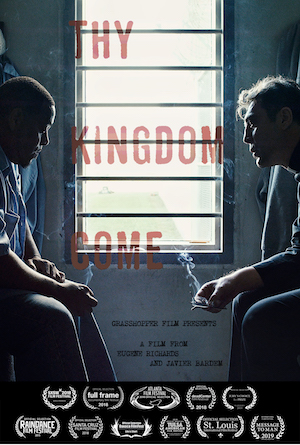
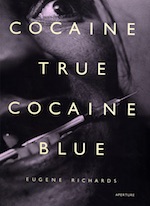
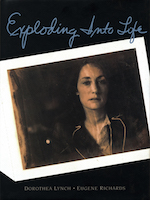
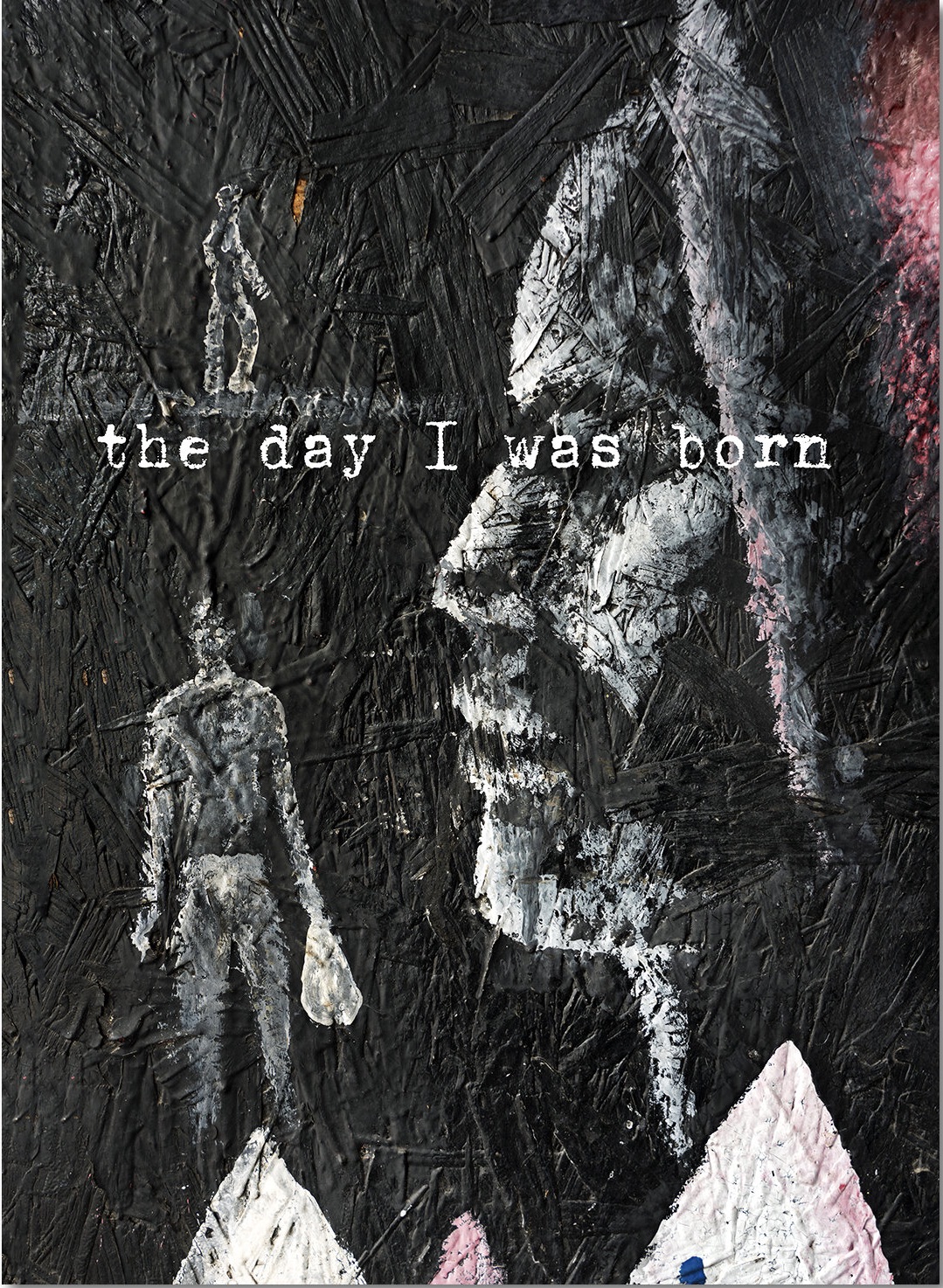
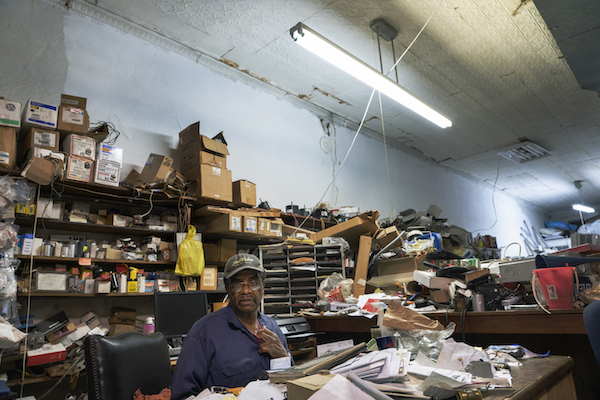
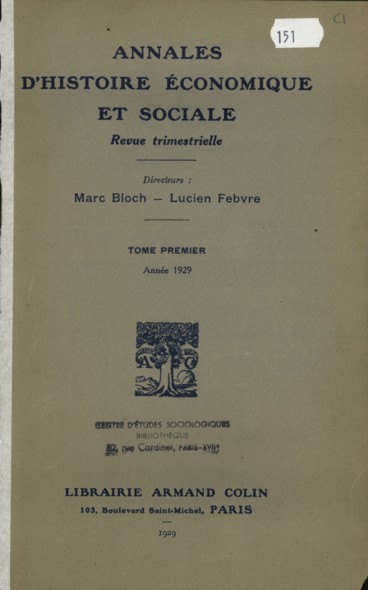
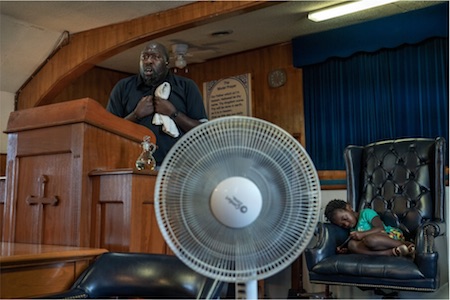

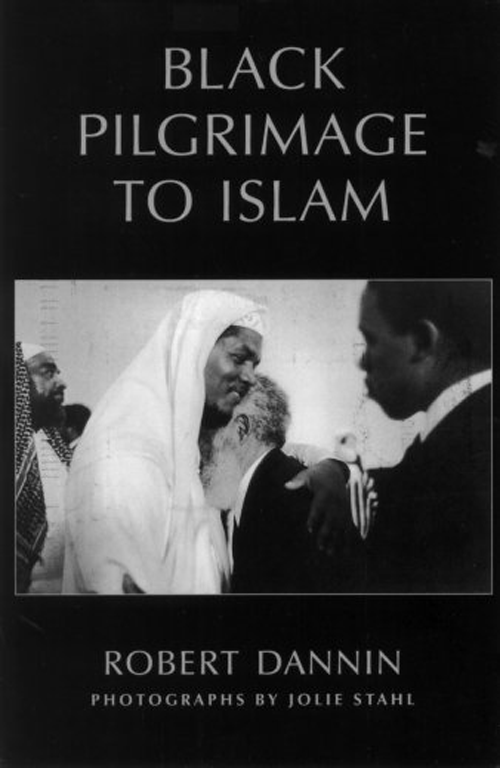




This is a very good pair of articles.
I remember Eugene Richards from when he used to turn up at Minor White’s house circa 1966-7, where we gathered to critique our photographs. Richards was quiet and thoughtful.